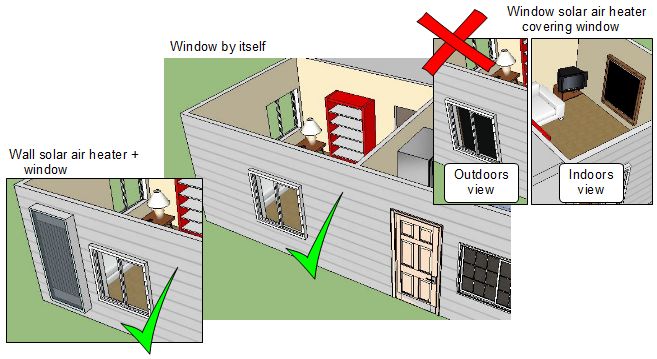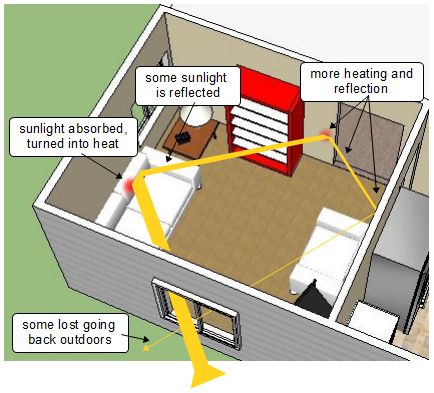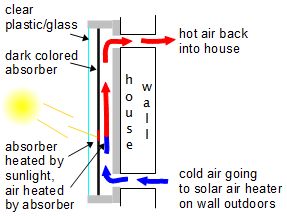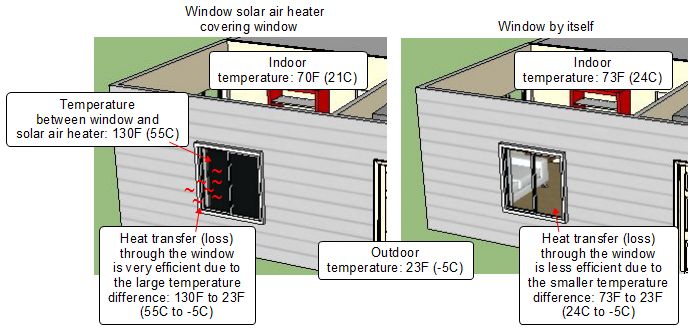Window solar air heaters that cover windows
A good window solar air heater is one that does not cover the window (see diagram below.) If the solar air heater covers most or all of the window then you are not doing better than leaving the window by itself, and you're likely losing energy. The solar air heater should add to the window's sunlight collection area, not replace it. This is shown below as a solar air heater mounted on the wall beside the window.

There are also solar air heater designs where the solar air heater sits outdoors below the window and interacts with the room by sliding the window open a little. On the right is a photo of one I built. Unfortunately it wasn't large enough to add much heat, but it didn't block much of the window. The curtains are closed because I was testing at the time.
Why doesn't a solar air heater that covers the area of a window help? Let's look at the two different scenarios and compare.
How sunlight heats a room
As illustrated below, when sunlight enters a room through a window, some of it is absorbed by the furniture, applicances, floor, walls, ... immediately and turned into heat. Some bounces around room a bit before being being turned into heat. And a little reflects back out the window.
This means that all the items in your room are acting parts of a large solar air heater. That's why if you leave your curtains open on a sunny day the room heats up. I have big south facing windows and my temperature increase due to the windows is around 9F (5C), from 66F (19C) to 73F (24C). That's on a day when the outdoor temperature is around 23F (-5C).

How a solar air heater works
A solar air heater has a dark material called an absorber. When sunlight hits this absorber much of it's energy is turned into heat, just as happened with the furniture in your room. Cold indoor air enters the solar air heater and takes heat from the absorber. That now heated air reenters the house and mixes with the indoor air.

Heat loss through windows
If you block out the window with a solar air heater then the dark absorber of the solar air heater is very near the window. Since the the sunlight is being turned into heat in a small area the temperature gets quite high. Heat transfer is more efficient when there is a larger temperature difference. So you have a high temperature absorber right next to a window on the other side of which is the cold outdoors. Heat loss through the window will be very efficient. If you go outdoors and place your hand against the window you'll feel the glass is warm, the heat is leaking through the glass.
If instead all the objects in your room are acting as the absorber converting sunlight to heat then the temperture near the window won't be so high. All the same energy is captured but it's spread out over a larger area. That means the temperature of the air near the window is not as high as it would be if you have a solar air heater pressed up against it. So there is less heat lost through the window.

You can find sample heat loss calculations about this situation on the page all about calculating heat loss.
Insulation
The walls of the room are situated inside the house so this heat will mostly stay inside and spread around. If instead you have a solar air heater next to the window then your hottest air is near the window and the outdoor facing wall. That again leads to greater heat loss to the outdoors through the window and the wall.
Doesn't a solar air heater covering the window means less heat loss at night?
Yes, it does. This is like saying that if you don't have a window then you have less heat loss at night. However, you don't get as much heating when the sun is shining as discussed above.
To prevent heat loss through windows at night, you can have thick curtains that you close, or as I do, a combination of blinds and curtains. Even better, you could have some form of insulation that you put in the windows. They can even be in the form of indoor shutters. This doesn't add any extra work since closing curtains in the evening and opening them in the morning is a normal activity.
At least in this way during the day you'll get all the free heating and enjoyable sunlight.
When does a solar air heater make sense?
A solar air heater makes sense when it adds to your existing sunlight collection area. A window solar air heater beside your window or one that hangs down below your window adds to your collection area. Just make sure it's a big enough collection area to actually make a difference.
